by Daniel J. Leonard | Jul 3, 2018
Each time I travel to central and south Florida and observe the wonderfully flamboyant tropical flora, I am reminded of the unique and frustrating climatic characteristics of Northwest Florida. Our weather is tropical enough through the summer to sustain virtually everything our friends to the south grow, but winters north of the Big Bend are just cold enough to prevent long-term success with most tropical species. However, the genus that is maybe most synonymous with tropical color, the Hibiscus (it even has its own texting emoji!), contains several species that are hardy through our winters. The best landscape plant of these hardy Hibiscus species is creatively (sarcasm) called Hardy Hibiscus or Giant Rose Mallow (Hibiscus moscheutos) and is an absolute star in the Panhandle, bringing the beauty of the tropics to your yard!
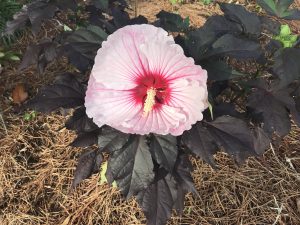
Hibiscus ‘Starry Starry Night’ – Photo courtesy Daniel Leonard
Rose Mallow is a native perennial species that occurs in sunny wetlands across the eastern U.S. This species can grow 7-8’ in height in its natural, unimproved state and possesses the largest flowers of any hardy perennial, some varieties easily eclipse 12” in diameter. Rose Mallows bloom through the heat of our long summers and return reliably each winter unfazed by frost. The flowers also happen to be a favorite of butterflies and hummingbirds and bring beneficial wildlife to the landscape. These characteristics and the trend towards the use of pollinator friendly, low-maintenance native perennials in landscapes quickly made Rose Mallow a jewel for plant breeders and now virtually all major horticultural brands have a line of Hardy Hibiscus available at garden centers, in varying sizes, flower color and leaf color/form. Recent breeding efforts have focused on introducing plants with enormous, richly colored flowers held on compact plants with attractive foliage. The results have yielded two series and three individual cultivars that I consider superior selections and are more than worthy of inclusion in your garden:
- Summerific® Series by Proven Winners. This series is comprised of four robust (up to 5’ in height) cultivars, ‘Cherry Cheesecake’ (bicolor magenta and white flowers), ‘Berry Awesome’ (purplish lavender flowers), ‘Cranberry Crush’ (a red you really have to see to believe), and ‘Perfect Storm’ (notable for its deep purple foliage).
- Luna Series by Monrovia. This series is notable for its ultra-compact (3’ in height or less) size and characteristically large flowers. It is also composed of four cultivars, ‘Luna Red’ (deep red), ‘Luna Blush’ (white, fading to pink near flower margins), ‘Luna Pink Swirl’ (pictured and my favorite, bicolor swirly flowers), and ‘Luna White’ (white with a red center).
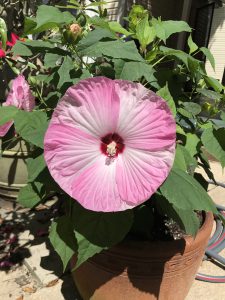
Hibiscus ‘Luna Pink Swirl’ – Photo courtesy Daniel Leonard
- ‘Starry Starry Night’ by Walter’s Gardens. (Pictured) This cultivar combines dark purple to black leaves with swirled pale and dark pink flowers. It has performed very well in my landscape and if I could only grow one, this might be it.
- ‘Lord Baltimore.’ The classic, large growing cultivar with bright red flowers that is widely available and easily found. An oldie (introduced in 1955) but a goodie.
- ‘Midnight Marvel’ by Walter’s Gardens. A “hot off the press” new cultivar that is currently difficult to find due to popularity, though some online outlets have them available in small sizes. This one is worth your patience. Sporting deep red blooms on near black foliage, there’s nothing else like it in the landscape.
In addition to being gorgeous plants, Rose Mallows are extremely versatile in the landscape and could not be easier to grow. Because the size varies so greatly (from the diminutive 30” tall ‘Luna’ series to the 8’ tall unimproved species), there really is a place for one in every garden. I like to use the smaller cultivars in large containers to facilitate moving them around where their floral display has the greatest impact or to create a tropical effect where in ground plantings are not an option (pool decks, patios, etc). The larger cultivars make spectacular specimen plantings in perennial and shrub beds and even make a really dense, striking hedge (just know they disappear in the winter). Be sure to give them as much sun as possible, as this will enhance the number of flowers on each plant and darken the foliage on the cultivars with purplish/black leaves. Too little sun will result in fewer flowers and lighter green foliage. As wetland plants, Rose Mallows enjoy regular water, either from rainfall or irrigation; they will let you know when they need it – their large leaves readily wilt under drought stress, somewhat like Hydrangea.
For low-maintenance, native, pollinator friendly, cold-hardy tropical color, you need look no further than Rose Mallow. These perennial shrubs come in all sizes and colors and fit any landscape! Look for the above listed series and cultivars at better garden centers and online retailers and enjoy the oohs and ahhs elicited when people first get a glimpse of Hardy Hibiscus in your landscape! Happy Gardening!
by Daniel J. Leonard | Aug 11, 2017
Growing in containers can be one of the most versatile ways to add color, texture and mobility to the landscape. However, gardeners generally reach for finicky annuals to fill their pots with pizzazz. The problem with this strategy is that most annuals and perennials need to be watered constantly, fertilized regularly, and changed out with the seasons. That sounds like a little bang for a whole lot of buck! I and most of the real plant people I know fall squarely in the school of lazy gardening and believe there is an easier, less intensive, and ultimately less expensive way to get the same result. This can be accomplished by thinking outside the box and using an alternative class of plants that can fit the same bill of providing color and texture in pots without the headaches and have been sitting on the shelves right in front of us the whole time, the shrubs.
It is beyond me why shrubs aren’t used as container plants more often. Maybe the reason for the lack of use is pure perception; after all, no one with any sense would plant a giant, coarse green meatball or an enormous antebellum azalea in a decorative pot on their front walk. Recent innovations by plant breeders have left this argument moot though as new introductions of old species have revived interest in the entire group. Many of the best of these new cultivars sport traits perfect for container culture (dwarf growth habit, increased flowering, and interesting texture and form) while preserving the ironclad, undemanding nature of their parent plants. The following are a few of my favorite new shrub introductions for container growing!
- ‘Purple Pixie’ Loropetalum
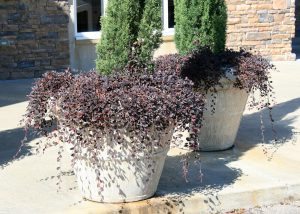
Purple Pixie loropetalum is a low-growing shrub that can spill beautifully out of a container. (Photo by MSU Extension Service/Gary Bachman)
If interesting architecture is what you require in a plant, ‘Purple Pixie’ must be on display in your yard. This dwarf cultivar of the wildly overused purple shrub Loropetalum chinense has taken the horticultural world by storm. The unique combination of true purplish foliage that only greens slightly in the hottest summer sun, ribbon-like pink spring flowers, and a graceful weeping habit make ‘Purple Pixie’ a winner. Give this plant a medium sized container (at least 12” in diameter), water when the soil begins to dry, fertilize infrequently with a slow-release formulation, site in full sun to partial shade, and enjoy for many seasons to come.
This is definitely not your granddaddy’s Ligustrum. Gone are the rampant growth, sickly sweet smelling flowers, and the aggressive nature of ‘Sunshine’s’ parent Chinese Privet (Ligustrum sinense). ‘Sunshine’ is a sterile cultivar with dwarf characteristics (growing 4-5’ with infrequent light pruning), vivid yellow-chartreuse foliage, and most importantly, no flowers. All ‘Sunshine’ asks of us is plenty of sun, occasional fertilizer and a light haircut once or twice a season! Use this plant to frame a dark flowerbed or in a container as a companion to the previous plant, ‘Purple Pixie’ Loropetalum for an extremely striking combination!
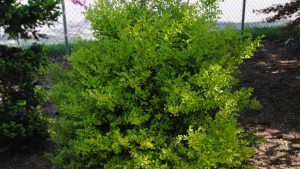
‘Sunshine’ Ligustrum. Photo courtesy of JC Raulston Arboretum.
A new take on a landscape standard, ‘Baby Gem’ is an exceptionally compact and slow growing cultivar of Buxus microphylla var japonica. All the same features gardeners love about traditional “full-size” boxwoods remains (tight, formal growth habit, ability to prune into many different shapes and ironclad constitution) but with ‘Baby Gem’ are delivered in a perfect package for a pot. This little “gem” of a plant is perfect for use in a smallish container to frame a formal landscape or to give a sense of order to an informal container garden or border!
So if you’re ready to stop replacing all of your potted plants each and every season, reach for one of these shrubs the next time you are at a garden center. You’ll likely be rewarded with compliments on your creativity, four season interest from the plants themselves, and more time to enjoy being in your garden instead of laboring in it! As always, if you have any questions about this or any other horticultural topics please contact your local UF/IFAS Extension office! Happy Gardening!
by Mark Tancig | Apr 24, 2017
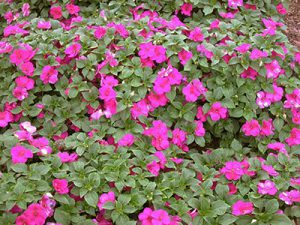
Source: UF/IFAS.
Impatiens are a very popular annual, bedding plant that provide a nice burst of color in the landscape. The traditional Impatiens (Impatiens walleriana), or touch-me-not, is the one that most gardeners know as needing part shade, but there are also the New Guinea Impatiens (Impatiens hawkeri) that are able to tolerate more sun. In addition to being able to withstand more sunlight, the New Guinea Impatiens also have larger flowers and leaves. Another highlight of the New Guinea impatiens is their increased resistance to downy mildew, a major concern for growers of touch-me-nots, especially in south Florida.
While native to the Old World, Impatiens are not known to invade Florida natural areas but may reproduce by seed. Touch-me-nots are known to spread easily be seed. An interesting fact about Impatiens is their bursting seed pods that can send seeds several feet from the parent plant. This characteristic is what led to the scientific name Impatiens – for impatient – and one of the common names – touch-me-not.
May is a good time to plant Impatiens in north Florida. They prefer slightly acidic soil and should be planted at a 12-18 inch spacing. Impatiens work well as a border planting or in mass plantings. While New Guinea Impatiens tolerate more sun, they still would prefer some afternoon shade. Those growing in full sun will need extra care to ensure they remain well watered. An all-purpose plant food can be applied at monthly intervals for best performance.
Some common varieties of touch-me-nots include ‘Accent’, ‘Blitz’, ‘Carousel’, ‘Dazzler’, ‘Impact’, ‘Impulse’, and ‘Super Elfins’. Common New Guinea Impatiens varieties include ‘Celebration Candy Pink’, ‘Celebration Light Lavender’, ‘Nebulus’, ‘Equinox’, ‘Sunglow’, and ‘Tango’. The newer ‘Sunpatiens’ variety is quite popular and comes in different forms – compact, spreading, and vigorous.
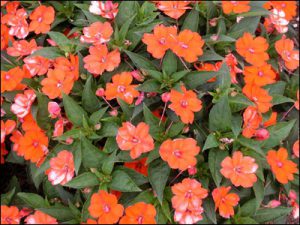
Source: UF/IFAS.
If you have any questions regarding Impatiens, please contact your local UF/IFAS Extension Office or visit our EDIS website at www.edis.ifas.ufl.edu.
by Matt Lollar | Apr 13, 2017
Most of you plant a spring vegetable garden with a number of different vegetable types. However, you may not realize that you are improving the health of your soil and your crops by planting a diverse garden. Intercropping is a gardening practice of growing different crops in the same field. When planting a mixture of crops in the same field year after year, it is important to rotate the location of each type of vegetable. This is a practice known as crop rotation. Intercropping and crop rotation will help reduce insect pest populations, increase beneficial insect populations, and reduce weed populations.
Crop Diversity
Growing plants in your garden that pest insects don’t like to eat makes the pests work harder to find what they do like to eat. Studies have found reduced whitefly numbers on squash plantings mixed with a crop of buckwheat when compared to squash planted alone. Another crop mixture that may be unintentional, but may work in your favor is a row of crapemyrtles along the edge of your garden. Crapemyrtles will attract the crapemyrtle aphid which will attract predatory insects. When the predatory insects run out of crapemyrtle aphids to eat, they will move to your garden and begin to hunt pest insects on your vegetable crop.
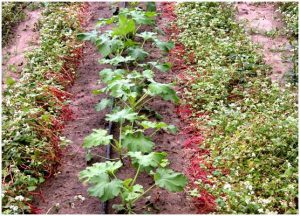
Squash with living mulch of buckwheat. Photo Credit: Oscar Liburd, UF/IFAS Extension
Trap Cropping
A trap crop is a plant that attracts a pest insect away from your food crops. Trap crops work best when planted at the edge of your garden, along a fence row, or in movable containers. A bare space, let’s say 5 feet or so, should be kept between your trap crop and your garden. This will help keep the pests from moving on to your vegetables. When you find a good population of pests on your trap crop then it is time to spray them with insecticide or cut the crop down and remove the debris to a location far from your garden. If your trap crops are planted in containers, then it makes them that much easier to remove from near the garden area.
Cover Crops and Green Manure
Soil organic matter can be increased by the use of green manure and cover crops. Cover crops are generally planted during the off-season, but they can be planted in between vegetable rows and tilled in at a designated time as a green manure. Both cover crops and green manure improve the production of your garden by:
- Suppressing weeds by competing for water, light, and nutrients;
- Holding the soil in place and preventing erosion;
- Scavenging for nutrients that can be utilized in future crops;
- Reducing nematode populations;
- Providing a habitat for beneficial insects.
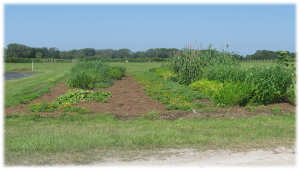
A mixed plot of cover crops and trap crops. Photo Credit: UF/IFAS Extension
A number of different crops can serve as cover crops or green manure crops. Most are legumes (bean family) or grasses. A few that you might like to give a try are:
- Cowpeas
- Sunn hemp
- Sorghum-sudangrass
- Winter rye
More detailed information on cover crops and green manure can be found at this link: http://edis.ifas.ufl.edu/aa217.
by Julie McConnell | Apr 7, 2017
It’s really tempting to buy a tree and plant it in the middle of your lawn or directly in front of your picture window, but instead take some time to choose the best spot first. Several considerations such as maintenance and mature size should be taken into account before the site is selected.
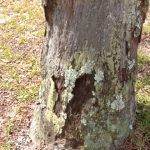
Mowing close to the trunk of this Pindo palm has caused repeated injury to the trunk. Photo: JMcConnell, UF/IFAS
Placing a tree in a lawn area without creating a bed can lead to maintenance issues for both the tree and the turfgrass. It is easy to simply cut out a small patch of turf the size of the rootball and install a tree, however, as the grass grows up towards the trunk over time maintaining that grass will become difficult. It is common to see mechanical injuries to tree trunks because weed eaters or mowers have chipped away at the bark when trying to cut the grass. Other potential problems are irrigation zones calibrated for turf delivering the wrong amount of water to trees and herbicides used on grass that may cause injury to trees.
Over time, as the tree canopy grows, it will create shade and any grass trying to grow in that area will thin and be more susceptible to disease and insect pressure. By creating a large ornamental bed for your tree, you will prevent some pitfalls associated with placing the tree in the lawn.
Another common mistake is planting a tree too close to a house or other structure. It can be difficult to imagine how large a tree will grow at maturity because it is not a quick process. Trees placed close to houses may grow into eaves and shed leaves onto roofs and into gutters. This adds to maintenance and can provide mosquito breeding grounds. Also, some tree roots may interfere with walkways or septic systems and should be sited far enough away to avoid these issues.
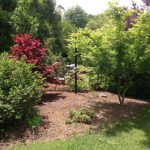
These Japanese Maples are planted in a bed separate from the lawn making care for both plant types easier. Photo: JMcConnell, UF/IFAS
Be sure to research any tree you plan to install to find out ideal growing conditions and mature size. If you plan ahead and use good maintenance practices, a tree can become an valuable part of your home landscape to be enjoyed for years to come.










